Growing up in our small neighborhood in Pilar, Bataan, the sound of "Binatooooog!" would send me and my sister Jehan racing down our stairs every afternoon around 3 PM, our coins jingling in our pockets.
We'd excitedly watch Manong Rey scrape fresh coconut right there on his wooden cart, the sweet aroma mixing with the steam rising from his aluminum pot of perfectly cooked white corn kernels. That first warm, slightly salty bite of Binatog, with its tender corn and fresh coconut strips, became our cherished after-school ritual.
Now living away from home, I've perfected this binatog recipe that takes me right back to those carefree merienda moments with Jehan.
Once you try making this classic Filipino street food at home, you'll understand why generations of Pinoy kids have fallen in love with this simple yet delicious combination of white corn, fresh coconut, and memories.
What is Binatog?
Binatog is a traditional Filipino street food made of boiled white corn kernels topped with freshly grated coconut, margarine, and a sprinkle of salt or sugar. In Filipino culture, it's often associated with afternoon merienda (snack time) and is particularly popular during the rainy season.
Jump to:
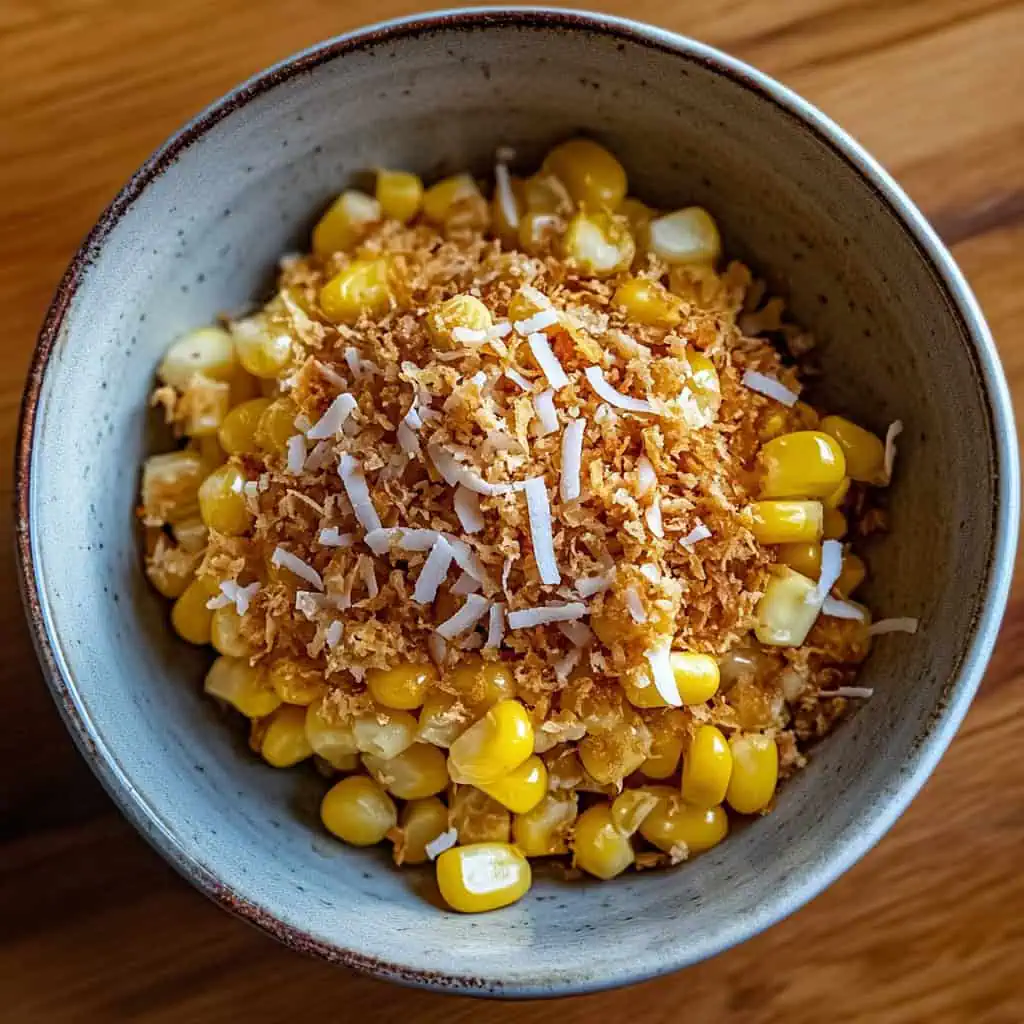
Why You'll Love This Recipe
- Authentic Taste: Experience real Filipino street food flavor at home
- Simple Ingredients: Only 4 main ingredients needed
- Customizable: Adjust sweetness and saltiness to your preference
- Budget-Friendly: More affordable than store-bought snacks
- Perfect Texture: Achieve that signature tender-chewy bite
- Kid-Friendly: A healthy alternative to processed snacks
Ingredients
This traditional recipe uses white corn for its unique chewy texture and mild sweetness that pairs perfectly with fresh coconut. The coconut adds a tropical creaminess, while margarine brings richness.
The option of salt or sugar allows customization between savory and sweet versions, creating a simple yet balanced snack that has stood the test of time in Filipino cuisine.

- 6 ears white corn (puting mais)
- 2 cups freshly grated coconut
- Margarine or butter, to taste
- Salt or sugar, to taste
- Water for boiling
Equipment
- Large pot (kaldero): For boiling the corn kernels thoroughly and evenly
- Colander (salaan): Essential for properly draining the cooked corn
- Fork (tinidor): Used specifically for removing kernels from corn cobs while preserving their shape
- Serving bowls (mangkok): Traditional way to serve individual portions
- Grater for fresh coconut (kudkuran): To create the perfect coconut strips for topping
- Measuring cups: For accurate ingredient portions
- Wooden spoon: For gently stirring the corn while cooking
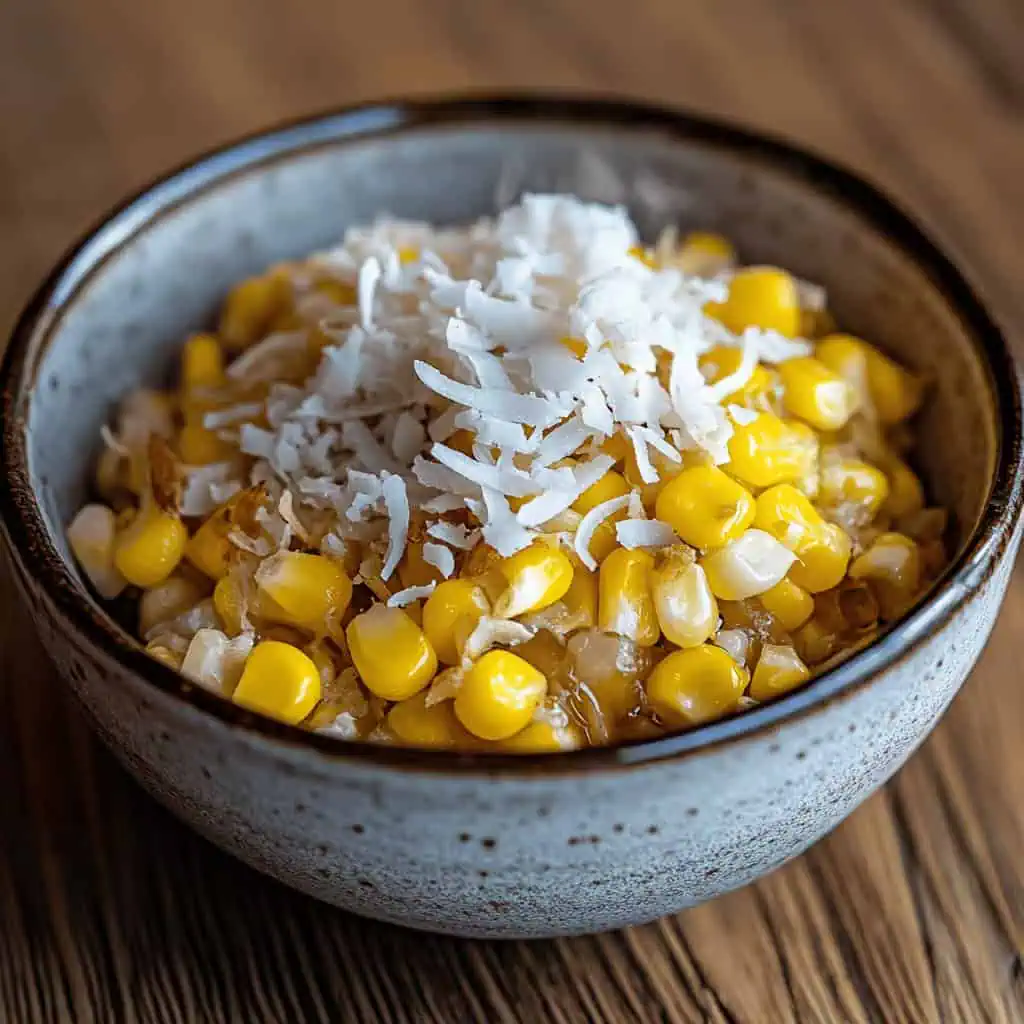
How To Make
- If using fresh corn ears, carefully remove the kernels using fork tines. Insert the fork between kernels and gently pry them off, keeping them whole to maintain the traditional texture. Never use a knife as this will damage the kernels' texture.
- Place the corn kernels in a large pot and add enough water to cover them completely. Bring to a gentle boil over medium heat - you should see small bubbles, not a violent boil.
- Reduce heat to low, cover the pot, and simmer for 15-20 minutes until the kernels are tender but still hold their shape. Test a kernel for doneness - it should be chewy but not mushy. Drain thoroughly in a colander.
- While the corn cooks, prepare fresh coconut if using a whole one. Grate it just before serving for the best flavor and texture. Have your margarine or butter ready at room temperature for easy spreading.
- Portion the warm corn into serving bowls. Top generously with freshly grated coconut, add your desired amount of margarine, and finish with a sprinkle of salt or sugar according to preference.
- Serve immediately while still warm, traditionally between 3-5 PM for merienda time. Offer both salt and sugar on the side so everyone can adjust to taste.

Tips from Lola's Kitchen
- Select the right corn: Use mature white corn, not sweet corn or yellow corn for authentic flavor and texture
- Preserve kernel integrity: Never use a knife to remove kernels - the fork method preserves the traditional texture
- Fresh is best: Fresh coconut is significantly better than packaged versions
- Timing matters: For authentic taste, grate coconut just before serving to maintain its flavor and aroma
- Gentle cooking: The water should be just hot enough to see small bubbles, not violently boiling
- Perfect tenderness: Cook until kernels are tender but still have a slight resistance when bitten
- Balanced flavors: The combination of slightly salty corn with fresh coconut creates the perfect balance
- Traditional touch: Serve in small bowls with wooden spoons for an authentic experience
Substitutions
- Corn: If white corn is unavailable, frozen Asian white corn or canned hominy can work (less authentic but acceptable)
- Fresh Coconut: Frozen grated coconut (defrosted and warmed) is the next best alternative
- Margarine: Butter or coconut oil can be used as substitutes
- Sugar varieties: Brown sugar or muscovado sugar can replace white sugar for a deeper flavor
- Vegan option: Use coconut oil instead of margarine or butter for a fully plant-based version
- Salt alternatives: Sea salt or pink Himalayan salt can add a subtle mineral flavor
Troubleshooting
- Tough Kernels
- Extend cooking time by 5-minute intervals
- Check water level regularly and add more if needed
- Ensure you're using the right type of corn (mature white corn works best)
- Mushy Texture
- Reduce cooking time in your next batch
- Ensure proper draining after cooking
- Cook at a lower temperature with a gentler simmer
- Kernels Breaking
- Use the fork method for kernel removal
- Handle gently during the cooking process
- Avoid vigorous stirring while cooking
- Not Enough Flavor
- Use fresh coconut rather than packaged
- Ensure you're using enough salt or sugar
- Add a small pat of butter or margarine while the corn is still hot
Storage & Reheating
- Storage:
- Keep in an airtight container in the refrigerator for up to 3 days
- Store the coconut separately from the corn for best results
- Do not freeze prepared binatog as the texture will deteriorate
- Reheating:
- Microwave: Heat for 1-2 minutes with a splash of water to rehydrate
- Stovetop: Steam for 5 minutes or gently warm in a pot with a tablespoon of water
- Always add fresh coconut after reheating, not before
- Margarine and salt/sugar should also be added after reheating

FAQ
Where can I find white corn in the US?
Look in Asian markets, particularly in the Filipino or Korean sections. Check both the frozen and fresh produce areas. Some Latin American markets may also carry similar white corn varieties.
Can I use regular sweet corn instead of white corn?
While possible, the texture and taste will be different. Traditional binatog uses starchier white corn which provides the signature chewy texture that sweet corn cannot replicate.
How do I select and prepare fresh coconut?
Choose heavy coconuts with clear liquid inside (shake to test). Brown coconuts are more mature and better for grating. To open, locate the three "eyes" and pierce one with a screwdriver, drain the liquid, then tap firmly around the equator with a hammer until it cracks.
Is binatog gluten-free?
Yes, traditional binatog is naturally gluten-free, making it a perfect snack for those with gluten sensitivities.
Can I make binatog in advance for a party?
While best served fresh, the corn can be pre-cooked and reheated. Store the corn separately and add coconut, margarine, and salt/sugar just before serving for the best flavor and texture.
How can I tell if the corn is cooked properly?
Perfectly cooked binatog kernels should be tender but still have a slight resistance when bitten. They should hold their shape well and not be mushy.
What makes binatog different from regular boiled corn?
The specific variety of white corn used, the cooking method, and the distinctive combination with fresh coconut and margarine creates binatog's unique eating experience that differs from regular boiled corn.
Is binatog served hot or cold?
Binatog is traditionally served warm, not hot. The gentle warmth enhances the flavors and creates the perfect contrast with the fresh coconut.
Related
Looking for other recipes like this? Try these:
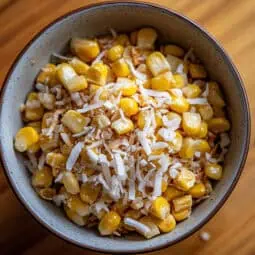
Binatog (Traditional Filipino White Corn with Coconut)
Equipment
- Large pot (kaldero)
- Colander (salaan)
- Fork (tinidor)
- Serving bowls (mangkok)
- Grater for fresh coconut (kudkuran)
Ingredients
- 6 ears white corn puting mais
- 2 cups freshly grated coconut niyog
- Margarine or butter mantikilya, to taste
- Salt asin or sugar (asukal), to taste
- Water for boiling
Instructions
- If using fresh corn ears, carefully remove the kernels (butil ng mais) using fork tines (gamitin ang tinidor). Insert the fork between kernels and gently pry them off, keeping them whole to maintain the traditional texture. Never use a knife as this will damage the kernels' texture.
- Place the corn kernels in a large pot (ilagay ang mga butil ng mais sa kaldero) and add enough water to cover them completely (lagyan ng tubig). Bring to a gentle boil over medium heat (pakuluan sa katamtamang init) - you should see small bubbles, not a violent boil.
- Reduce heat to low, cover the pot, and simmer for 15-20 minutes (pahinaan ang apoy at takpan) until the kernels are tender but still hold their shape. Test a kernel for doneness - it should be chewy but not mushy. Drain thoroughly in a colander (salain ng mabuti).
- While the corn cooks, prepare fresh coconut (niyog) if using a whole one. Grate it just before serving for the best flavor and texture. Have your margarine or butter (mantikilya) ready at room temperature for easy spreading.
- Portion the warm corn into serving bowls. Top generously with freshly grated coconut, add your desired amount of margarine, and finish with a sprinkle of salt (asin) or sugar (asukal) according to preference.
- Serve immediately while still warm, traditionally between 3-5 PM for merienda time. Offer both salt and sugar on the side so everyone can adjust to taste.
Tips from Lola's Kitchen
- Use mature white corn, not sweet corn or yellow corn
- Never use a knife to remove kernels - this preserves the traditional texture
- Fresh coconut is always better than packaged
- For authentic taste, grate coconut just before serving
- The water should be just hot enough to see small bubbles, not violently boiling
Nutrition
The Story Behind Traditional Filipino Binatog
Walking through the bustling streets of the Philippines, the familiar call of "Binatoooog!" echoes through neighborhoods, a sound that has been part of Filipino culture for generations. This beloved street food, made from tender white corn kernels and fresh coconut, tells a story of Filipino ingenuity and the simple pleasures of everyday life.
Binatog's origins can be traced back to the northern regions of the Philippines, particularly in the corn-growing provinces of Isabela and Cagayan. Here, farmers discovered that the native white corn variety, different from the sweet yellow corn commonly found worldwide, could be transformed into a delightful snack that would later capture the hearts of Filipinos across the archipelago.
The tradition of binatog vendors, known as "magbibinatog" in Tagalog, began in the 1940s when resourceful entrepreneurs would carry large aluminum containers balanced on bamboo poles, going door-to-door during the afternoon merienda hours. These vendors would prepare the corn fresh, keeping it warm throughout their journey, and would grate coconut on the spot – a practice that some street vendors maintain to this day.
What makes binatog truly special is its connection to Filipino agricultural heritage. The white corn used in traditional binatog isn't just any corn – it's a specific variety that's starchier and firmer than conventional sweet corn. This particular type of corn, when boiled to perfection, achieves a unique texture that's both tender and chewy, creating the signature bite that Filipinos have come to love.
In modern Filipino food culture, binatog has evolved from being solely street food to becoming a cherished home-cooked merienda. While the ingredients remain simple – white corn, fresh coconut, margarine, and a sprinkle of salt or sugar – the emotional connection to this dish runs deep. It represents afternoon gatherings with family, unexpected visits from friends, and the comforting rhythm of daily Filipino life.
Today, binatog can be found not just in the Philippines but in Filipino communities worldwide. From the streets of Manila to Filipino markets in California, New York, and beyond, this humble corn snack continues to bring a taste of home to Filipinos everywhere. Whether enjoyed on a rainy afternoon or as a weekend treat, binatog remains a testament to how the simplest foods often hold the strongest connections to our cultural identity.
The preparation of binatog, while straightforward, requires attention to detail that has been passed down through generations. The careful removal of corn kernels using a fork rather than a knife, the precise cooking time to achieve the perfect tenderness, and the generous topping of freshly grated coconut – these steps have remained unchanged, preserving the authentic taste that makes binatog a timeless Filipino favorite.
As modern Filipino cuisine continues to evolve and gain international recognition, binatog stands as a reminder of our culinary roots – where simple ingredients, prepared with care and served with love, create food memories that last a lifetime. Whether you're trying it for the first time or rediscovering a childhood favorite, each bowl of binatog tells a story of Filipino culture, community, and the enduring power of traditional street food.
This cherished merienda continues to bring joy to Filipinos around the world, one warm, coconut-topped bowl at a time.
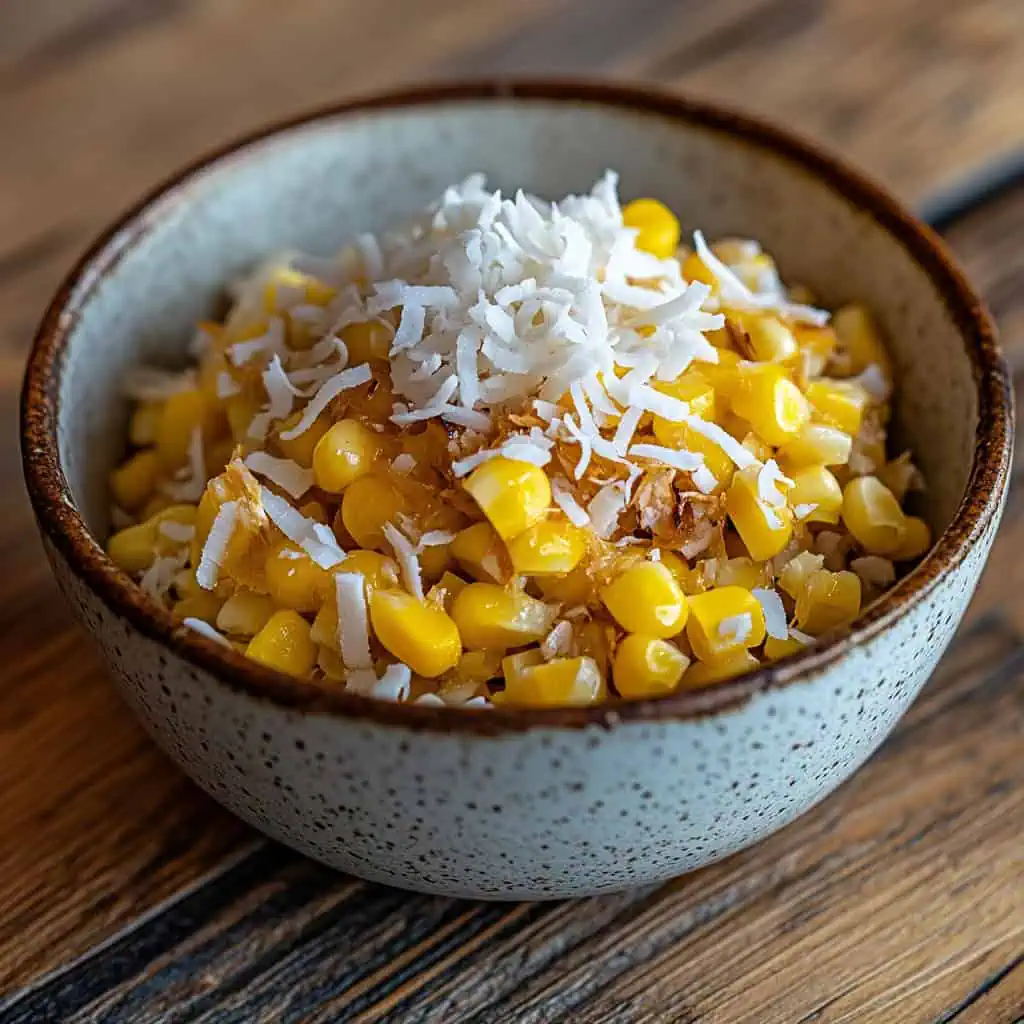







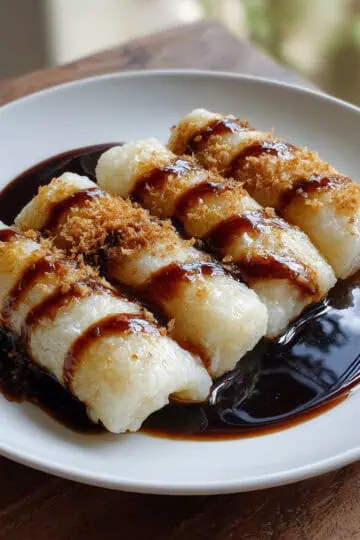
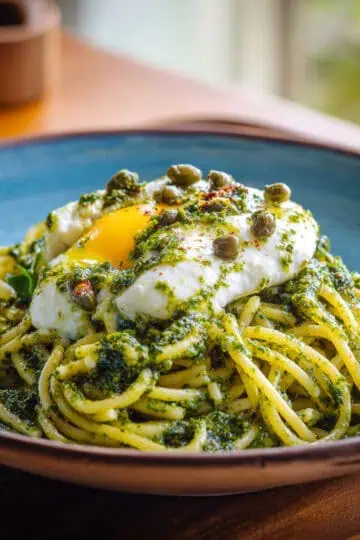
Comments
No Comments